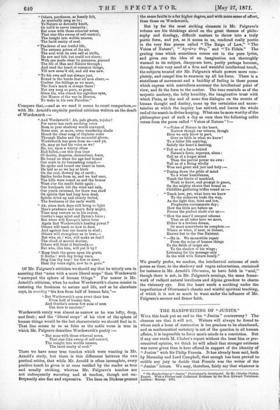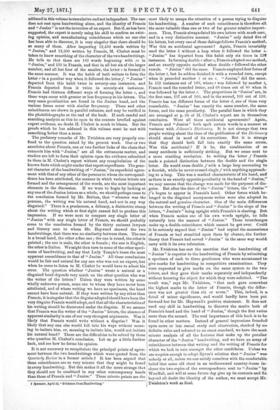THE HANDWRITING OF " JUNIUS."
WILL this book put an end to the "Junius" controversy? The- chances are that it will not. Writers will always be found to- whom such a bone of contention is too precious to be abandoned,. and as mathematical certainty is out of the question in all human. affairs, it is impossible to force men's minds to a conviction. But. if any one reads M. Chabot's report without the least bias or pre- conceived opinion, we think he will admit that stronger evidence- was never given than is here offered in support of the identity of " Junius " with Sir Philip Francis. It has already been said, both by Macaulay and Lord Campbell, that enough has been proved to- entitle any jury to decide that Francis was the writer of the "Junius" letters. We may, therefore, fairly say that whatever is.
* The Handteniting of" Junius" Professionally Investigated. By Mr. Charles Chabot, Expert. With a Preface and Collateral Evidence by the Hon. Edward Twisleton.. London: Murray. 1871, adduced in this volume is cumulative and not independent. The case does not rest upon handwriting alone, and the identity of Francis and " Junius " is not the invention of an expert. But if, as has been suggested, the expert is merely using his skill to confirm an exist- ing opinion, and manufacturing coincidences which no one else has been able to discover, it is very singular that there should be so many of them. After inspecting 12,450 words written by "Junius," and 12,500 written by Francis, M. Chabot must be taken to know something of the character of the two handwritings. He tells us that there are 183 words beginning with re in "Junius," and 132 in Francis, and that in all but six of the larger number, and all but four of the smaller, the letter r is formed in the same manner. It was the habit of both writers to form the letter r in a peculiar way when it followed the letterf. "Junius" departed from this habit twice in seventy-one instances, and Francis departed from it twice in seventy-six instances. Francis bad thirteen different ways of forming the letter r, and these ways occur with greater or less frequency in his letters. The very same peculiarities are found in the Junian hand, and the various forms occur with similar frequency. These and other coincidences are shown in parallel columns, and may be verified in -the photolithographs at the end of the book. If such careful and searching analysis as this be open to the censure levelled against expert evidence, no doubt M. Chabot is much to blame. But the proofs which he has adduced in this volume must be met with something better than a sneer.
The prefatory remarks of Mr. Twisleton are very properly con- fined to the question raised by the present work. One or two anecdotes about Francis, one or two further links of the chain that connects him with "Junius," are all the extraneous matter, and readers are left to form their opinion upon the evidence submitted to them in M. Chabot's report without any recapitulation of the known facts which might render that report superfluous. The gene- ral character of the handwriting of "Junius," its superficial agree- ment with that of any other of the persons to whom the correspond- deuce has been attributed, the manner in which various letters are formed and the arrangement of the words, are the most important elements in the discussion. If we were to begin by looking at any one of the Junian letters as a whole, we should perhaps come to the conclusion formed by Mr. Britton, that "whoever was the penman, the writing was his natural hand, and not in any way disguised." There is a preciseness, a delicacy, a distinctive stamp about the writing which at first sight cannot fail to produce this impression. If we were next to compare any single letter of " Junius " with any single letter of Francis, we should probably come to the conclusion formed by the thirty eminent lawyers and literary men to whom Mr. Hayward showed the two handwritings, that there was no similarity between them. The one is a broad hand, the other a fine one ; the one is round, the other is pointed ; the one is male, the other is female ; the one is English, the other is Italian. We might then turn to some of the other speci- mens of handwriting, and say that Lady Temple's bears the most apparent resemblance to that of "Junius." All these conclusions would be fair and natural for any one who was not an expert, but when he came to listen to M. Chabot he would have to admit his error. The question whether "Junius" wrote a natural or a disguised hand depends very much on the other question who was the writer of the letters ? Unless they were written by some wholly unknown person, some one to whom they have never been attributed, and of whose writing we have no specimens, the hand cannot have been natural. If they were written by any other than Francis, it is singular that the disguise adopted should have been the very disguise Francis would adopt, and that all the characteristics of his writing should be discovered under the disguise. If we assume that Francis was the writer of the "Junius" letters, the absence of apparent similarity is one of our very strongest arguments. Was it likely that Francis would write without a disguise? Was it likely that any one else would fall into his ways without mean- ing to imitate him, or, meaning to imitate him, would not imitate his natural hand ? These are the difficulties to be solved by those who question M. Chabot's conclusion. Let us go a little further back, and see how he forms his opinion.
It is not necessary to recapitulate the principal points of agree- ment between the two handwritings which were quoted from the Quarterly Review in a former article.t It has been argued that these coincidences are so very minute that they might be found in every handwriting. But this makes it all the more strange that they should not be combined in any other contemporary hands than those of Francis and "Junius." These minute points are the Spectator, Apri122, "Evidence from Handwriting." most likely to escape the attention of a person trying to disguise his handwriting. A number of such coincidences is therefore all. the more valuable than one or two of far greater relative import- ance. Thus, Francis always dated his own letters with much care, and in a very distinctive manner. " Junius " only dated five of his letters, but every one of those datings follows Francis's method.. Was this an accidental agreement? Again, Francis invariably used the letter h without a loop when it followed the letter s. "Junius" has departed from this habit only air times in 136' instances. In forming double r after o, Francis adopted one method,. and an exactly opposite method when double r followed the other vowels. " Junius " did the same. Francis employed four forms of the letter t, but he seldom finished it with a rounded turn, except when .it preceded another t or an r. "Junin" did the same.. In 159 instances out of 160, where t was followed by another 4. Francis used the rounded letter, and 68 times out of 80 when it was followed by the letter r. The proportions in "Junius" are, in. the first case, 107 out of 160, and in the second, 103 out of 120. Francis has ten different forms of the letter d, one of them very remarkable. " Junius " has exactly the same number, the same- forms, and the same peculiarity. The parallel lines in which they are arranged at p. 38 of M. Chabot's report are in themselves. conclusive. Were all these accidental agreements? Again,. Francis and "Junius" both spelt certain words in a manner at variance with Johnson's Dictionary. It is not strange that two people writing about the time of the publication of the Dictionary should stand in need of its corrections. But it is strange that they should both fall into exactly the same errors. Was this accidental ? If it be, the combination of so. many accidents is sufficiently striking. But we come next to. a more startling revelation. In writing the letter f Francis. made a pointed distinction between the double and the single letter. He would cross double f with a large loop amounting to. a flourish, while he never crossed singled` with anything approach- ing to a loop. This was a marked characteristic of his hand, and' as there is an exactly opposite peculiarity in the hand of "Junius," we may assume that the change was made for the purposes of dis- guise. But after the date of the " Junius" letters, the "Junius f's began to appear in Francis's band. Other forms which be- longed to the disguised anonymous writer were also adopted in. the natural and genuine character. One of the main difference& between the writing of Francis and " Junius" is the slope of the. letters, " Junius's " being upright while Francis's is slanting. But. when Francis makes one of his own words upright, he falls. naturally into the manner of "Junius." These interchanges. make up a double coincidence which cannot be got over. Could it be seriously argued that " Junius " had copied the mannerisms. of Francis or had stumbled upon them by chance, the further theory that Francis had served "Junius" in the same way would. carry with it its own refutation.
Mr. Twisleton has met the assertion that the handwriting of " Junius " is superior to the handwriting of Francis by submitting a specimen of each to three gentlemen who were accustomed to- give marks for handwriting in competitive examinations. They were requested to give marks on the same system to the two. letters, and they gave their marks separately and independently without knowing the object for which they were solicited. "The result was," says Mr. Twisleton, "that each gave somewhat the highest marks to the letter of Francis, though the differ- ence was not greater than six or seven." This, indeed, is a. detail of minor significance, and would hardly have been put forward but for Mr. Hayward's positive statement. It does not need any skill in handwriting to discover the merits both of Francis's hand and the hand of "Junius," though the first varies. more than the second. The real importance of this book is to be- found in other matters. Instead of general impressions founded upon more or less casual study and observation, checked by no. definite rules and referred to no exact standard, we have the most. minute analysis of all the features that make up the peculiar character of the " Junius " handwriting, and we have an array of coincidences between that writing and the writing of Francis for- which we look in vain amongst the other candidates. Unless we. are sceptics enough to adopt Byron's solution that " Junius" was- nobody at all, unless we can satisfy ourselves with the comfortable belief that some old chest in an undiscovered country-house in. closes the two copies of the correspondence sent to " Junius " by Woodfall, and will at some future day give up its contents and fim beyond all doubt the identity of the author, we must accept la. Twisleton's work as final.



































 Previous page
Previous page